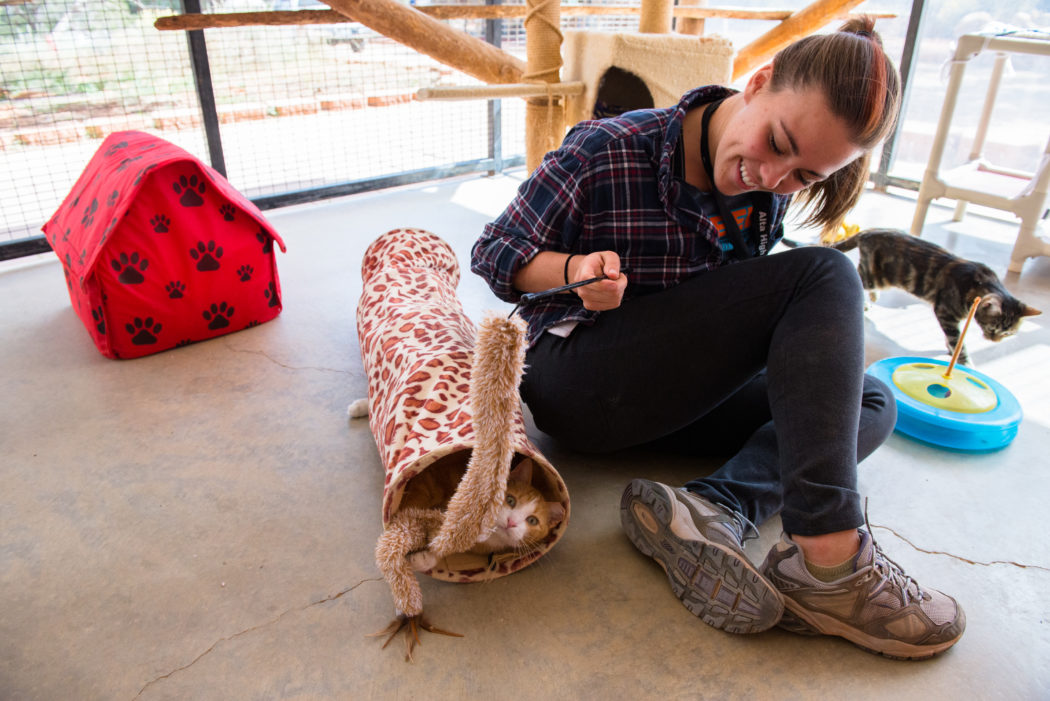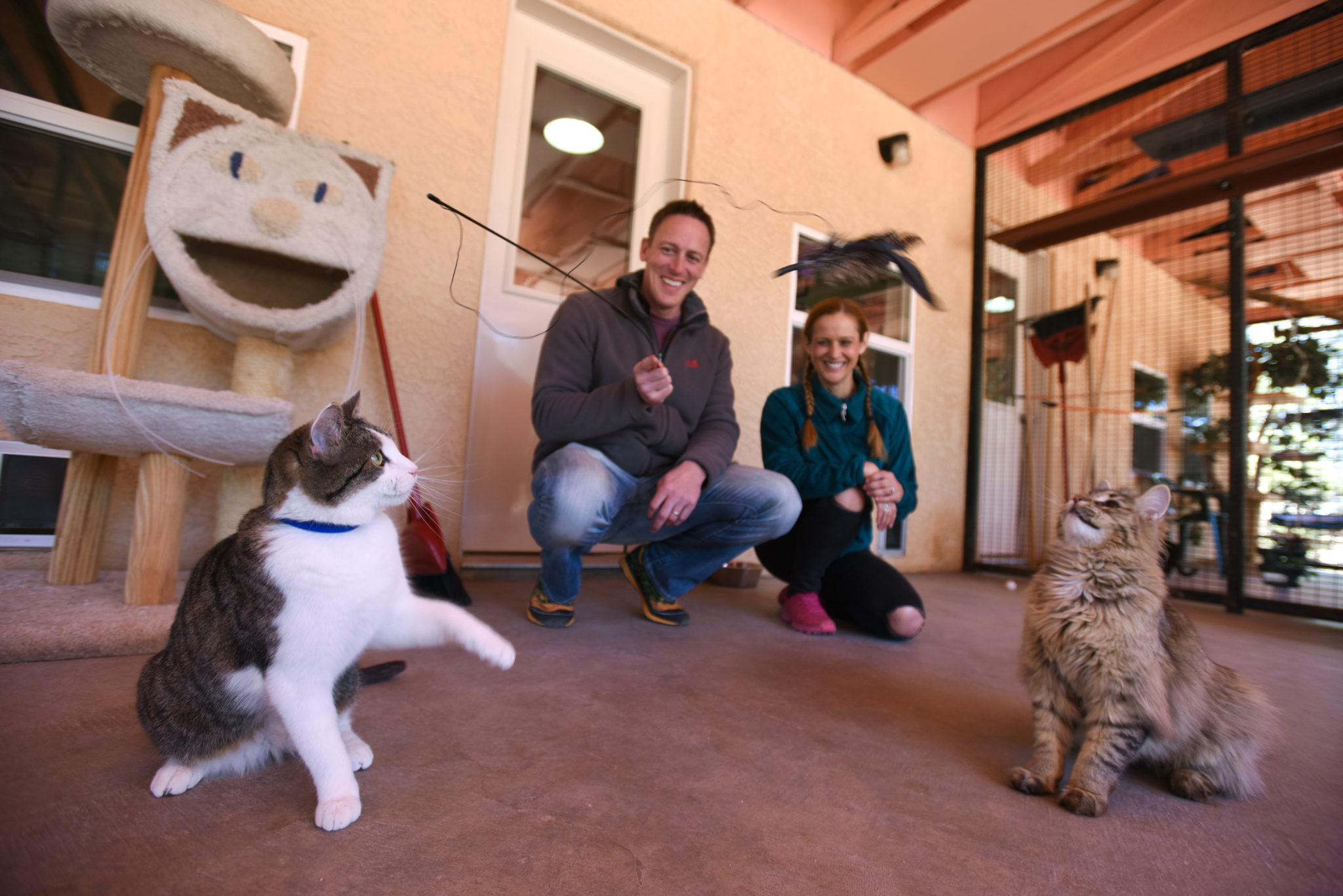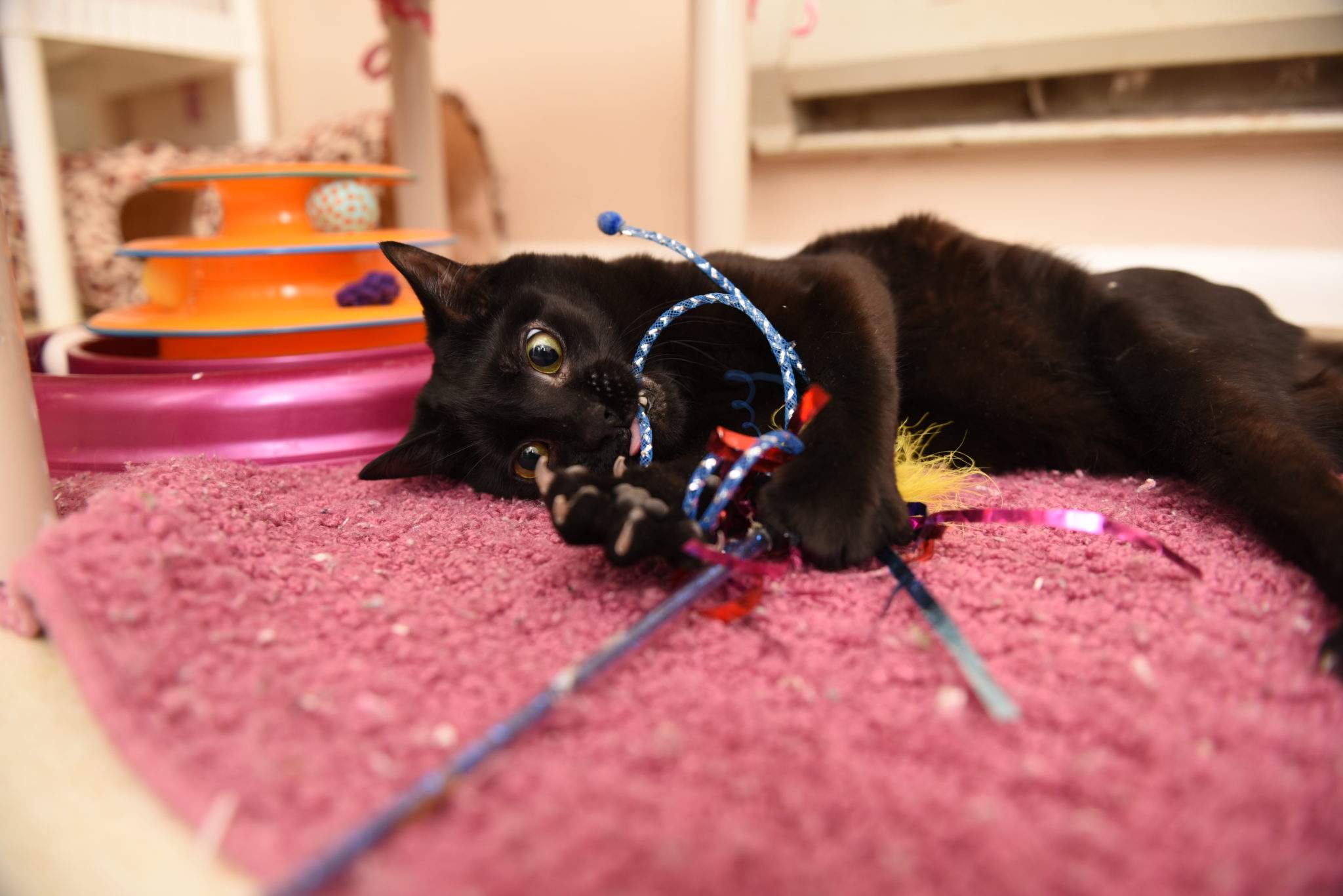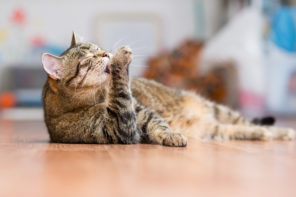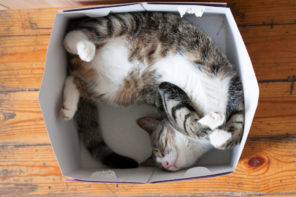We know that our indoor kitties require enrichment, activities that keep them mentally stimulated so they don’t become bored or depressed, but what about cats who are waiting to be adopted at an animal rescue center?
Adventure Cats reached out to four ameowzing rescue groups around the United States to find out what kinds of enrichment shelter kitties need while they wait for their forever homes and what new pet parents can continue to do to keep their rescue kitty as happy as pawsible.
We asked experts at Furkids in Atlanta, Georgia, Wallis Annenberg PetSpace in Playa Vista, California, Pasadena Humane Society & SPCA in Pasadena, California, and Best Friends Animal Society’s Sanctuary in Kanab, Utah all about their unique approaches to enrichment.
The ‘meow’ and why of enrichment
Adventure Cats works purrticulalry hard to dispel the stereotype that cats are loners who don’t need mental stimulation or physical exercise, and experts at the shelters we contacted agreed. They, too, educate people that cats need interaction and other forms of stimulation.
Rochelle Guardado, cat behavior specialist at Pasadena Humane Society & SPCA, explains the misconception they work to correct. “Many people mistakenly think that unlike a dog that needs daily walks, cats are ‘independent’ and don’t like exercise,” she says. “Cats are very social and thrive when they are active and part of the family’s daily routine.”
Wallis Annenberg PetSpace’s animal behavior and training coordinator, Eleasha Gall, discussed how kitties’ mental faculties are often underestimated and how PetSpace prevents boredom in their feline residents. “Cats are very smart, much more than most people give them credit,” she says. “In a home, when a cat has a behavior issue, a lot of the time it is due to the cat not being mentally stimulated enough. While training is used here, enrichment gives us help. Many shelters have cats that are highly stressed and get sick or cannot recover from being sick. Giving the cats an enriching environment helps with that.”
So let’s take a look at how these four animal rescue groups provide enriching environments and stimulating activities for their fuzzy tenants.
Types of shelter enrichment
Each rescue center is different, utilizing unique environments for their resident cats based on the size of the rescue facility to staffing availability and other factors. The rescues we spoke with have amazing programs and volunteer opportunities geared toward positive experience for their adoptable kitties.
These groups work hard to give their residents the best lives pawsible, and we want to commend them all fur that! Now, let’s look at the purrticulars of each rescue’s enrichment activities from playtime with people, to fun toys, to food puzzles and more.
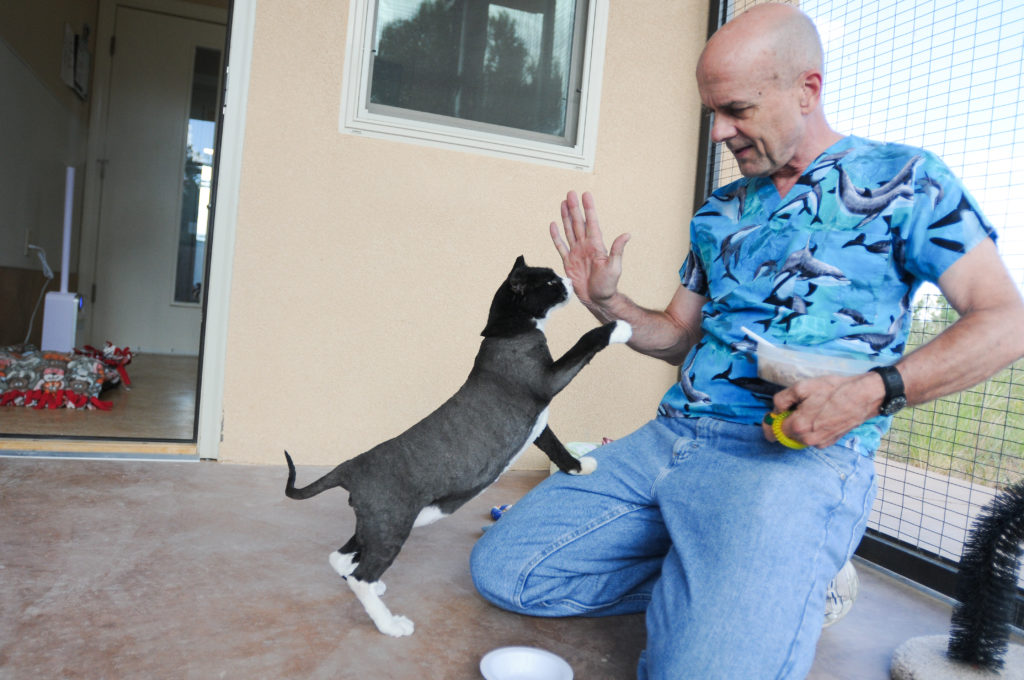
Dr. Frank and Mozart give enrichment a spirited high five. (Photo: Best Friends Animal Society)
Pasadena Humane Society’s Guardado told Adventure Cats how much the kitties at their Neely Cat Center enjoy enrichment from friendly human interaction. “Both volunteers and staff give the cats a choice in a variety of mental stimulation opportunities,” she says. “Some cats prefer playtime with various toys, others go for scent enrichment with catnip or silver vine twigs. Volunteers also provide gentle grooming and treat-dispensing toys to cats that show interest. We even have music for cats that sometimes includes birds chirping and other auditory interests.”
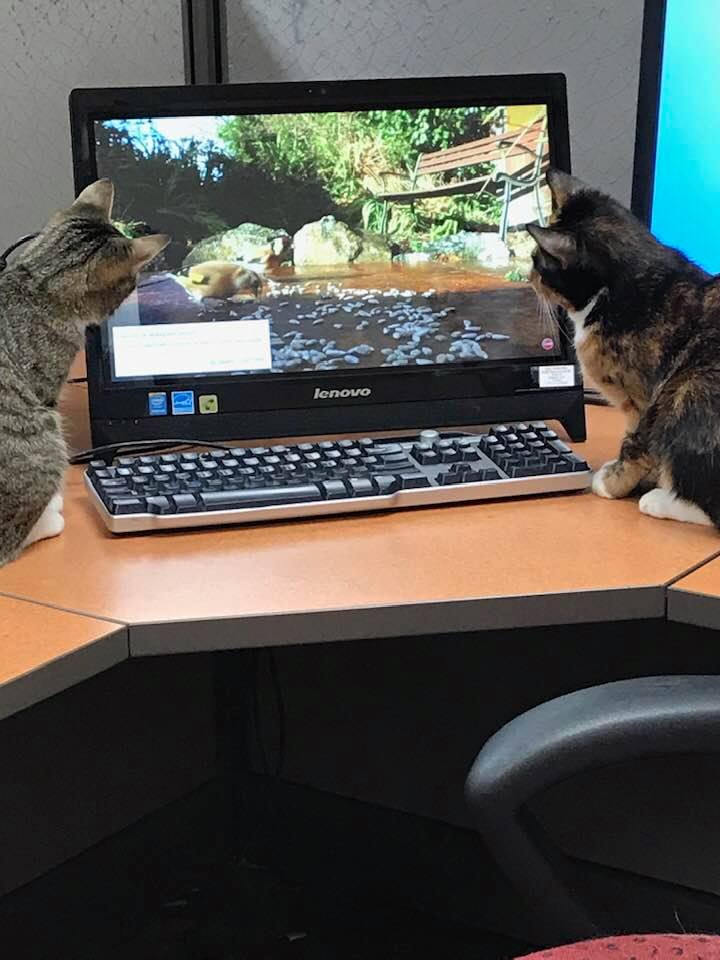
Ziggy and Silke aren’t actually IT cats; they’re just enjoying a little high-tech enrichment. (Photo: Furkids)
Enrichment like this is possible even if you’re not a feline expurrt though. Sometimes you just have to be a little creative. “One of our volunteers loves to sing to the kitties, and they really seem to perk up when he comes in to visit them,” Guardado says. That’s meowsic to our human ears, too.
Gall commented on PetSpace’s purrticular approach to kitty enrichment saying, “We are lucky enough here to have enough enrichment to fill an entire enrichment handbook! The most useful ones that get used on a daily basis are the toys we provide. We try to give each cat at least six different toys daily.
“With dogs, we change everything every day, but with cats, we may leave some items in their room for a few days in a row. Cats do well with their scent on items, so we don’t switch out their favorite toys too often.”
Gall also mentioned that food enrichment tools are a great way to keep shelter cats or your own cat stimulated. She recommends products from Catit and the No Bowl System from Doc and Phoebe, and she’s also a fan of the Ripple Rug.
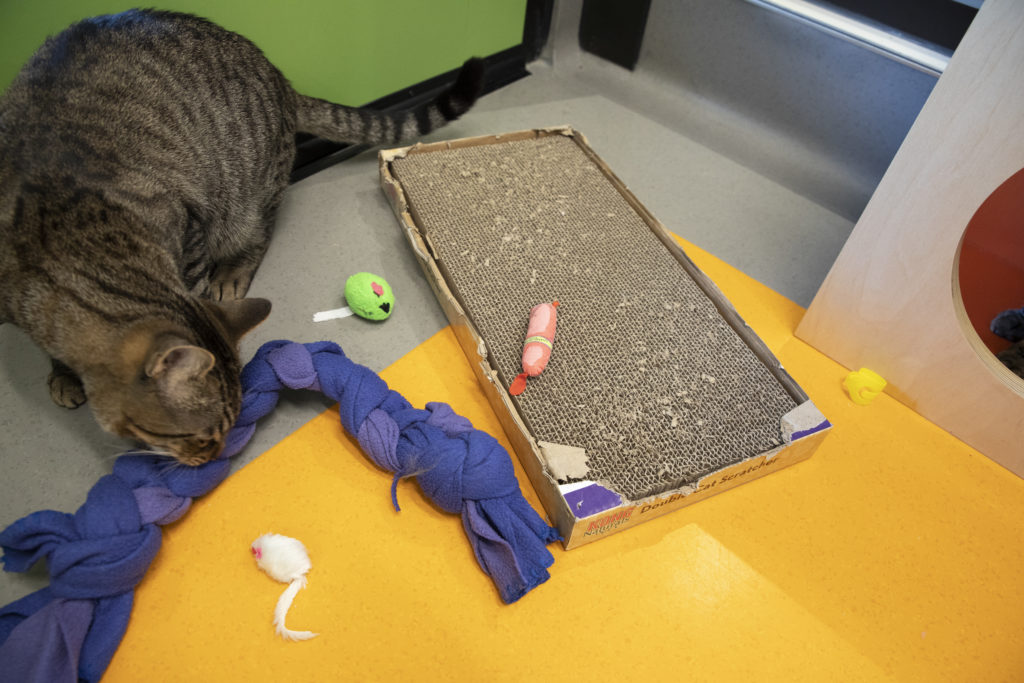
Kitty toys make for a fun, enriching time. (Photo: Wallis Annenberg PetSpace)
Food enrichment is also a key tool at Best Friends Animal Society’s Sanctuary. “The staff is able to give them food puzzles to enrich their minds; we play with them with toys and catnip,” said Cathy Bosley, Best Friends’ certified feline training and behavior specialist. “The caregivers also provide boxes and packing paper for the cats to play in, many times making forts [out] of the boxes for the cats to play hide-and-seek in.”
Because of the layout and the open-air accommodations of the sanctuary, the resident kitties are also able to go on many outdoor adventures. “The caregivers and volunteers alike will walk cats in specially made strollers where the cats can safely view and breathe the fresh air, Bosley says. “We also walk cats on harnesses where they can investigate the world at their eye level.”
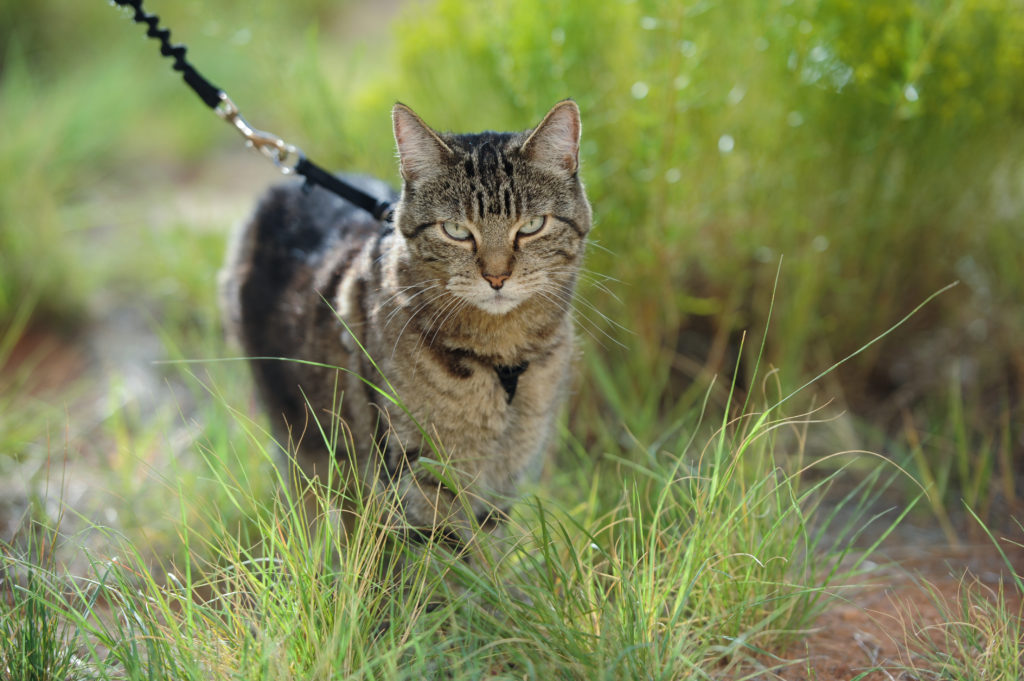
A rescue kitty enjoys a walk at the BFAS sanctuary. (Photo: Best Friends Animal Society)
Bosley noted another purrk enjoyed by the shelter kitties at Best Friends Animal Sanctuary: “The cat rooms at all have catteries where the cats can go to safely investigate the sights, sounds and smells of the great outdoors without the risk of harm.”
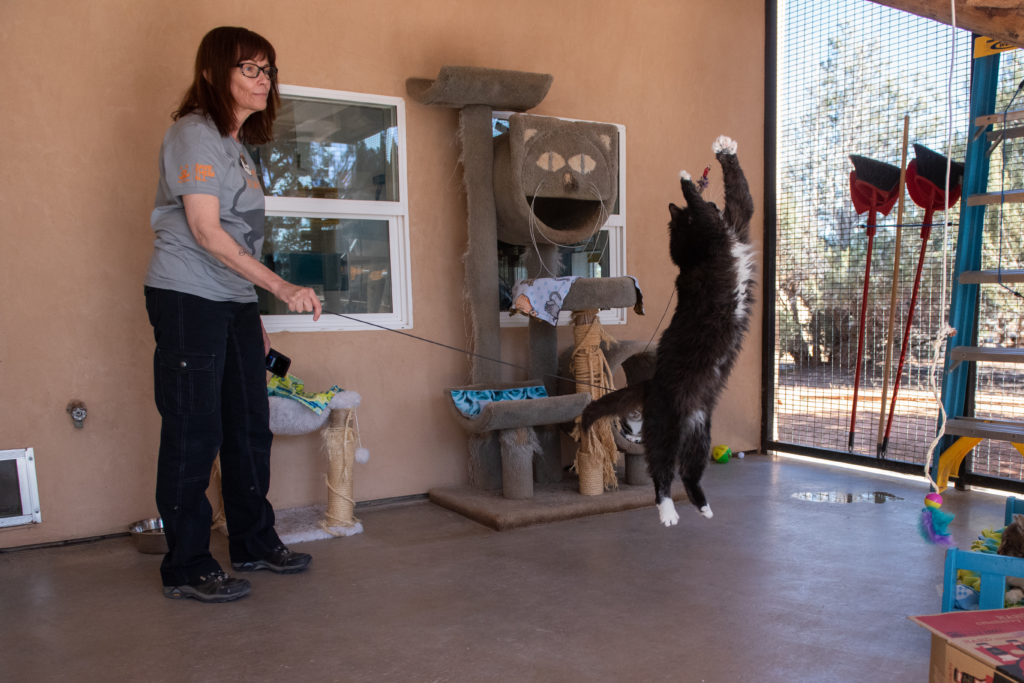
Kelly finds enrichment through spirited jumping. (Photo: Best Friends Animal Society)
On the other side of the country in Atlanta, Furkids, Georgia’s largest no-kill rescue also engages in a variety of kitty enrichment, including its involvement in Jackson Galaxy’s Cat Pawsitive program.
“In 2016, Furkids was selected as one of only nine shelters in the country to participate in Jackson Galaxy’s Cat Pawsitive program, a reward-based program where shelter staff and volunteers are trained to work with cats to reduce the stresses that might keep a cat from connecting with an adopter,” said Susan Segars, a Furkids representative. “With clicker training that positively reinforces good behaviors, cats gain confidence and get mental and physical stimulation through their clicker-training sessions, and soon they are building connections with staff, volunteers and potential adopters.”
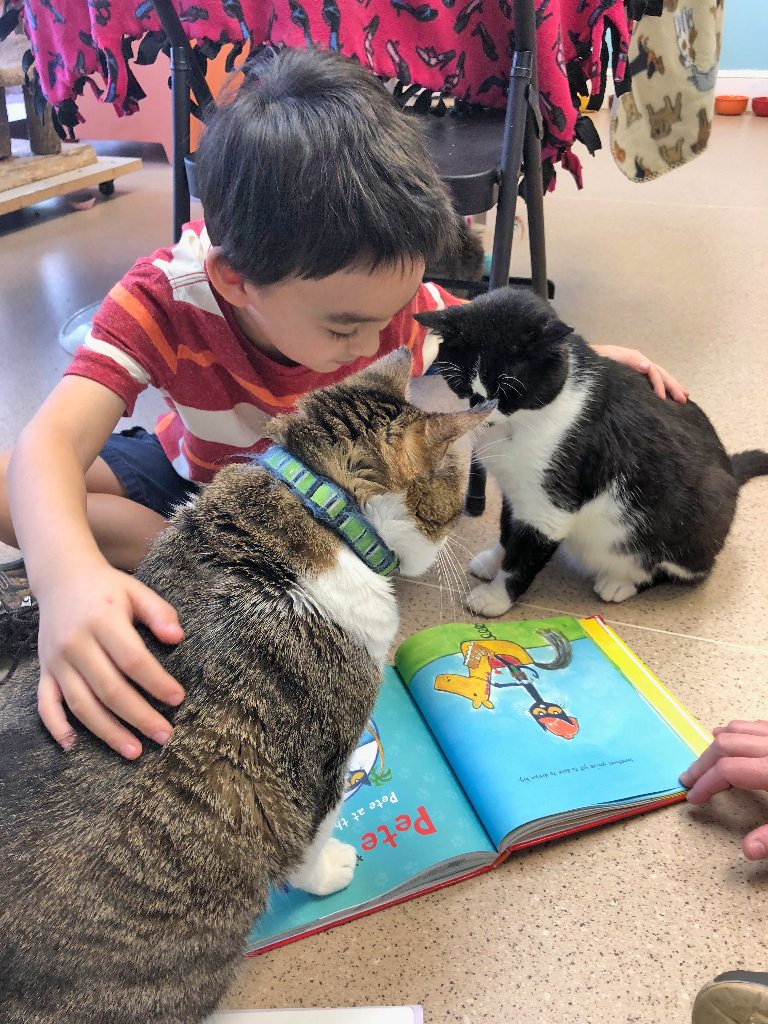
A boy reads to some very engaged kitties. (Photo: Furkids)
In addition to Cat Pawsitive, Furkids also has other types of enrichment programs. “Furkids has formal and informal methods to help keep our kitties happy and healthy until they find their forever home,” Segars says. “One of the most popular programs we have is FurTales, which helps children develop their reading skills while also helping to socialize shelter cats. FurTales is designed for volunteers under 16 years old who have reading requirements, or who just like to read. The program helps children learn to care for others and facilitates their understanding of the human-animal relationships that enrich all our lives.”
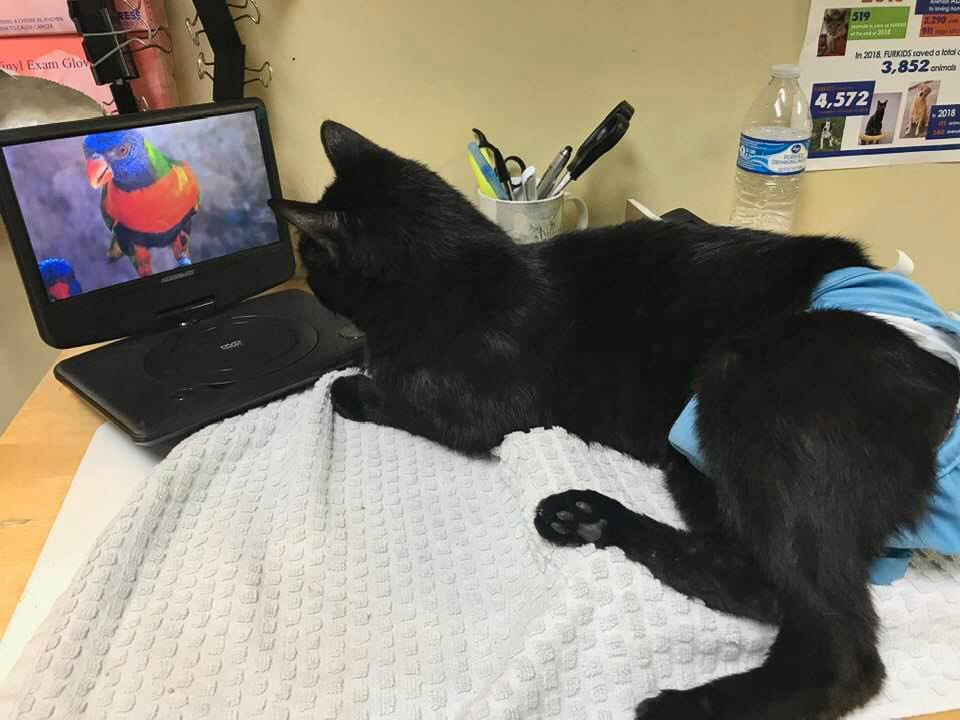
Rain, a longtime resident, knows that Furkids knows enrichment. (Photo: Furkids)
If FurTales wasn’t awesome and adorable enough, wait until you hear what Furkids said about their Purrkids program: “Our Purrkids program is focused on working with individual cats based on their individual enrichment and socialization needs,” Segars says. “Cats are identified and become Purrkids when they aren’t completely socialized, are fearful, shy or otherwise withdrawn. Each Purrkid cat is assigned to a volunteer who understands their needs and works with them one-on-one on a regular basis to instill trust and the ability to develop relationships with humans as well as other cats.”
Furkids also has partnerships with a local cat cafe and a network of 400+ foster homes, so adoptable cats can enjoy a change of scenery away from the rescue center.
Continuing enrichment with your feline friend
Not sure how to continue successful enrichment at home? Well, we asked the cat experts that very question, so you can give your kitty the best nine lives.
“When a cat comes home for the first time, it’s important to let the cat acclimate to its new surroundings,” Guardado says. “Building a bond with your cat will take some time, so giving the cat a choice to interact is very important. Once your new friend begins to find her confidence, you should spend some time investigating what kind of play your cat likes to engage in.”
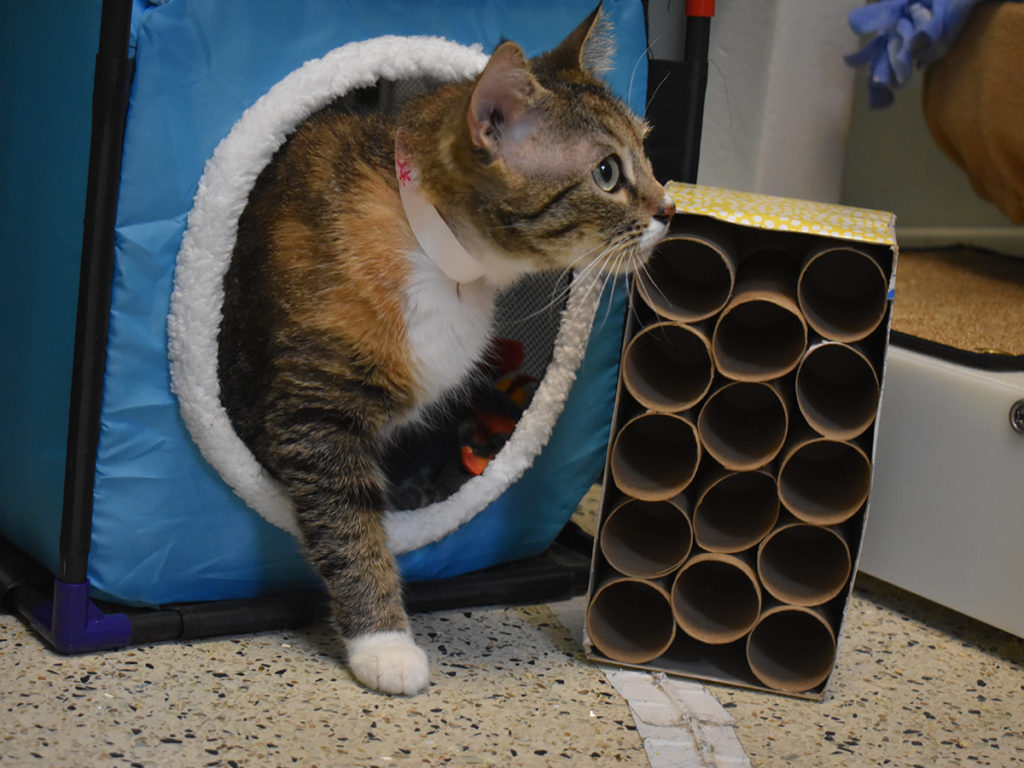
DIY enrichment tools are easy and fun. (Photo: Pasadena Humane Society)
“Every kitty is different, and we work hard to make sure every adopter gets a full briefing on the kitty they are adopting: what they are accustomed to (food, play, petting…), as well as their individual preferences (more/less attention, physical limitations, etc.),” Segars says. “We also let new adopters know what their new kitty could use more of that they can’t get in a shelter environment…Often, toys and other distractions are a great way to get kitty’s mind off the stress of relocation and new humans or animals for a while. Before they know it, they’ll feel right at home!”
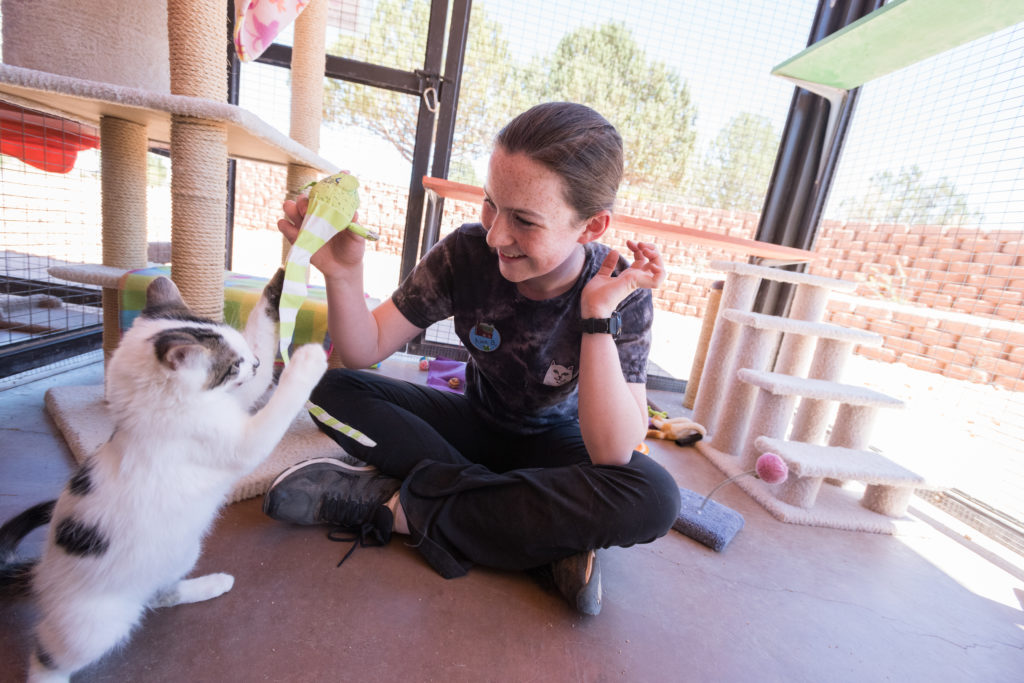
Enrichment is fun for everyone. (Photo: Best Friends Animal Society)
Bosley also suggests food puzzles and foraging as a great way to keep up enrichment activities at home. “Cats enjoy the thrill of the hunt for their food, and if we simply put the food in the bowl for them to eat without having them have to hunt for it, they can be bored easily and turn into chunky kitties,” she says.
“I would recommend getting into the habit of playing with them a bit before feeding them each time. Fifteen to twenty minutes would be enough time to get them the exercise they need. Use a string/wand toy to make them run and jump, then lead them to the food if you don’t have food puzzles.”
Bosley says DIY toys can also be great for enrichment, “You can make food puzzles out of everyday items in your house. Paper towel rolls will work if you make holes where treats can fall out.”
Another pawsome source of enrichment is a view of the great outdoors. “Putting a bird feeder or bird bath outside a window where they like to sit, [gives] them cat TV to watch,” Bosley says.
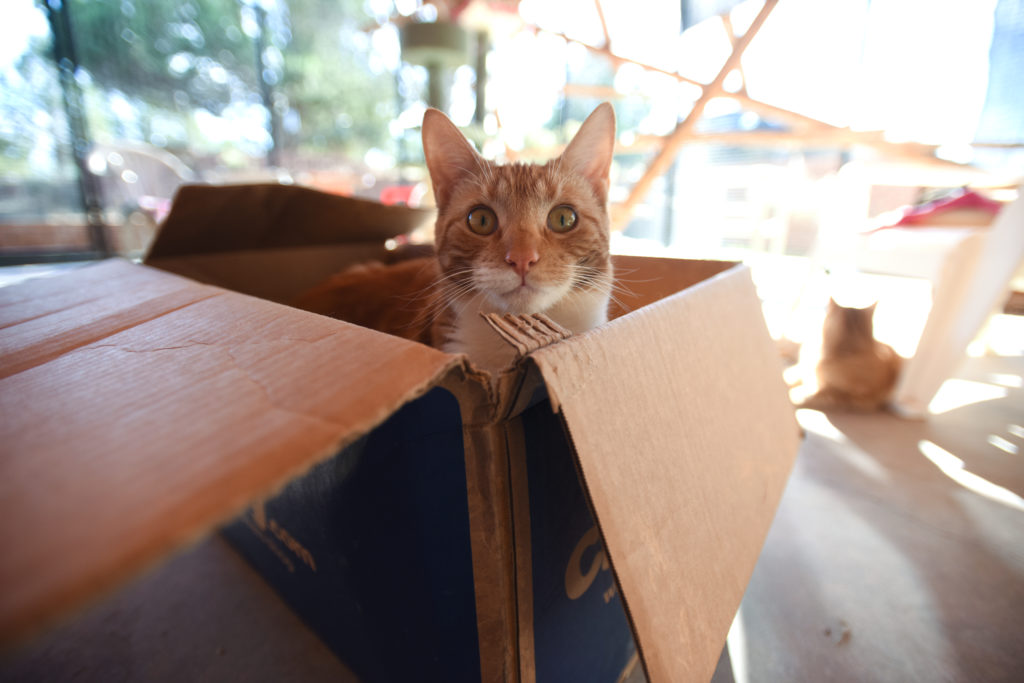
Cats like boxes. QED. (Photo: Best Friends Animal Society)
And don’t forget about boxes. “Even cats in homes love boxes, so use those for a while for the cats to play in and hide,” Bosley says. “The joke is that the box the toy comes in will be more fun for the cat than the toy itself. This seems to hold true.”
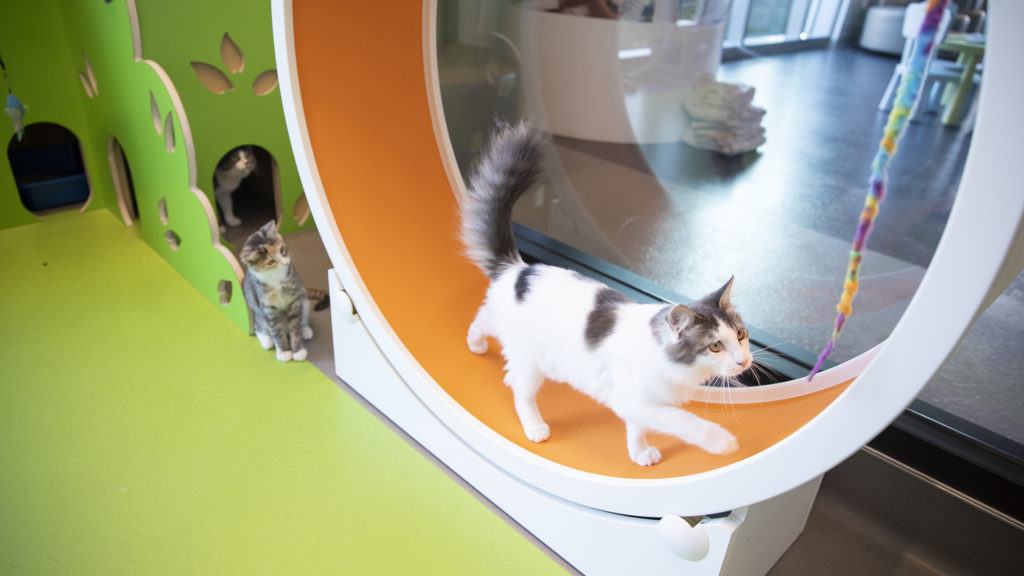
Wheels. Not just for hamsters anymore. (Photo: Wallis Annenberg PetSpace)
PetSpace’s Gall noted to take the transition slowly when introducing a kitty to a new home. “First, set the animals up for success with food, litter and getting started with your vet,” she says. “At home, allow your cat a few days-weeks to decompress. Try to keep the environment relaxed. Then, as you see your new cat is exploring their home, bring out some fun cat toys: some cat kickers and even interactive toys. Don’t start having the cat work for their food until they are fully settled in.”
Now that you know the why and meow of enrichment, you’re ready to adopt a kitty and keep him or her entertained and active. But wait, there’s even meowr you can do to help the shelter kitty enrichment cause.
Enrich a shelter cat: Volunteer!
If you want to help keep local shelter kitties happy and healthy while they wait for a forever home, contact your local rescue center and ask about volunteer programs.
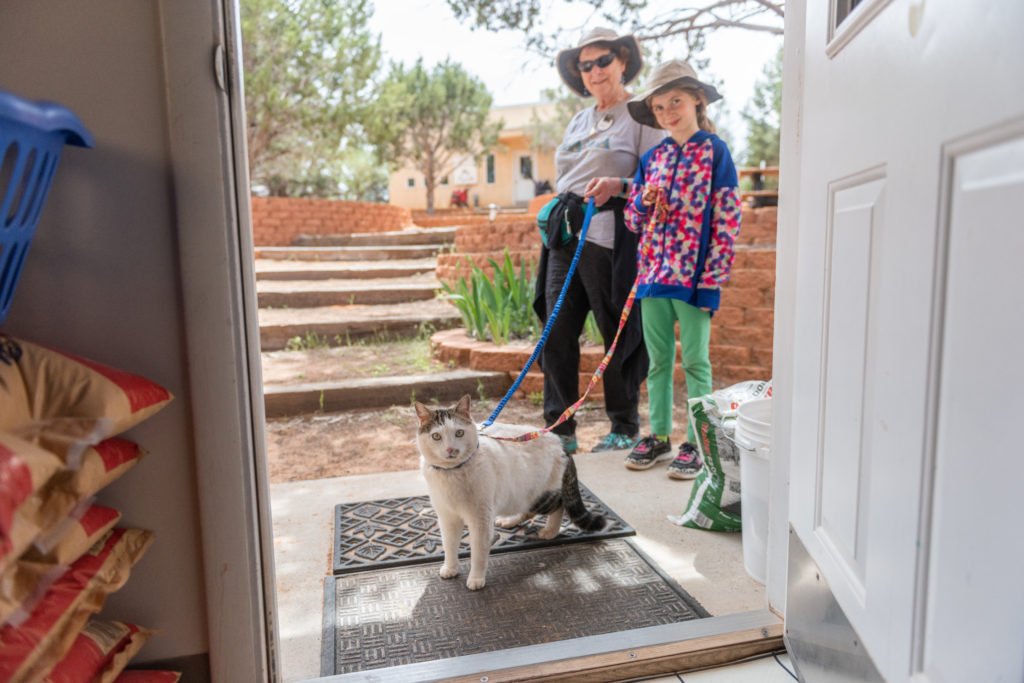
Open the doors to enrichment. (Photo: Best Friends Animal Society)
“Even if you only can volunteer a few hours a month you will make such a difference in how much the staff can do on behalf of the animals, and you will improve the lives of the cats in their care,” Bosley says.
So get out there and enrich the lives of local shelter kitties in need!

